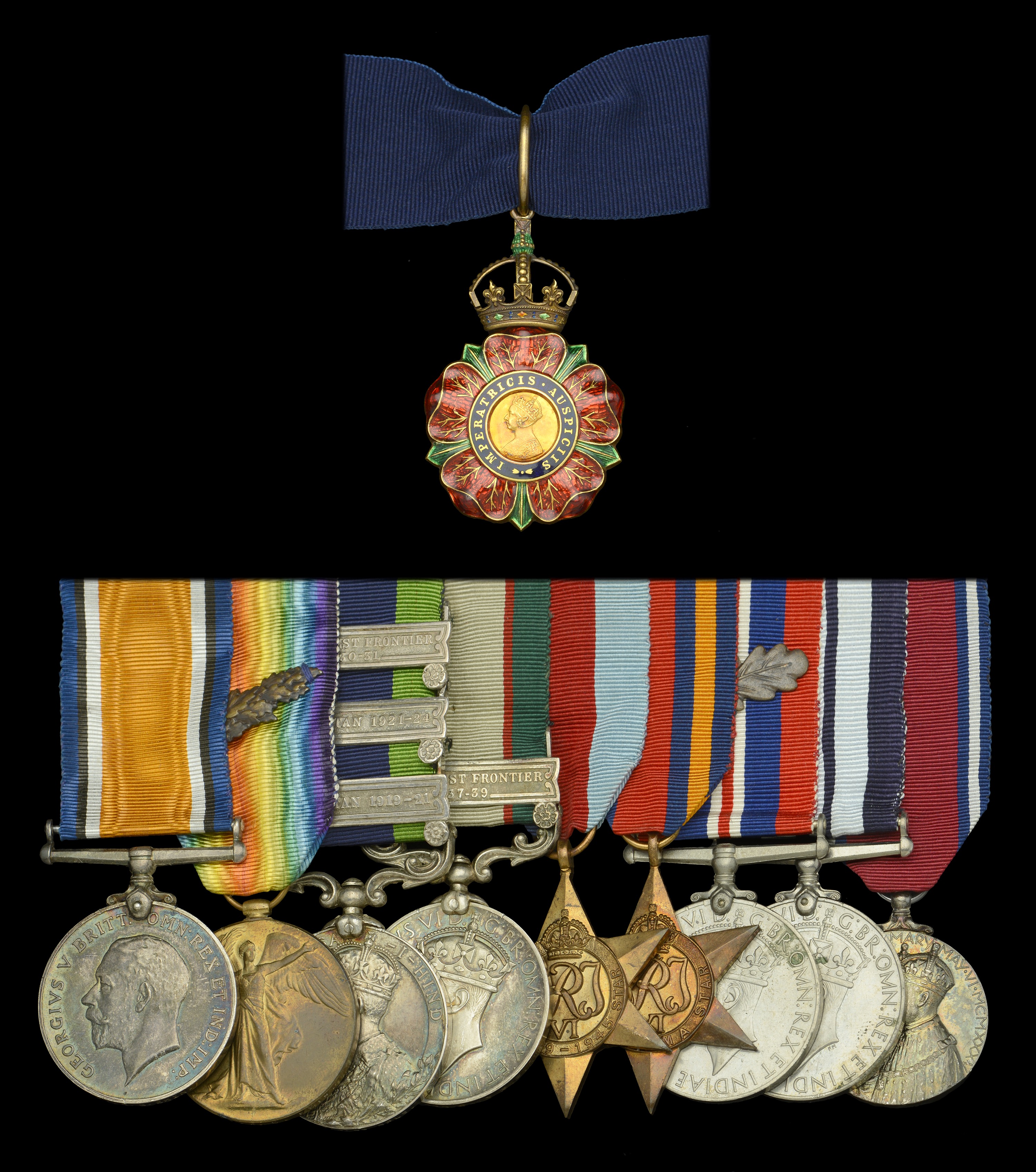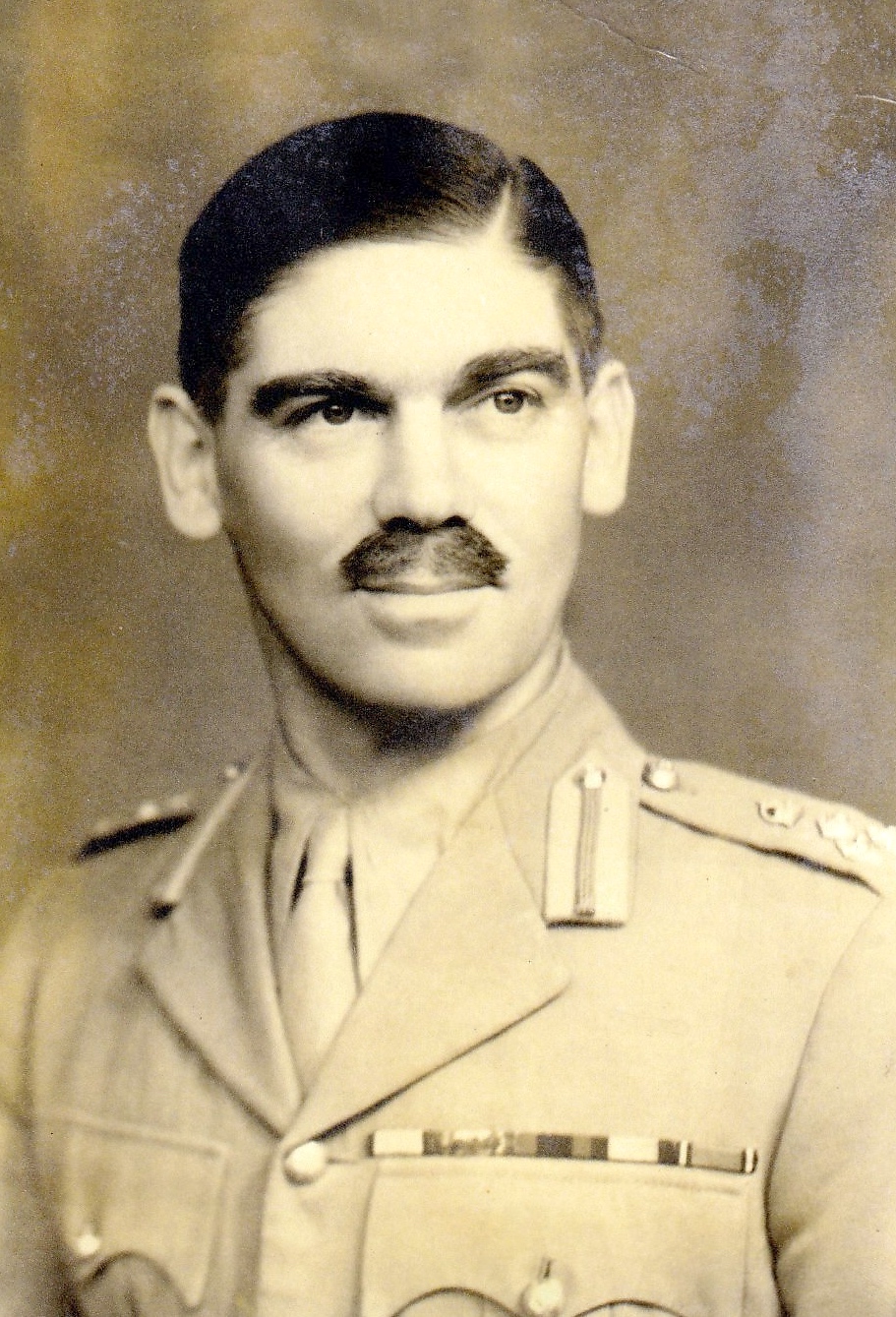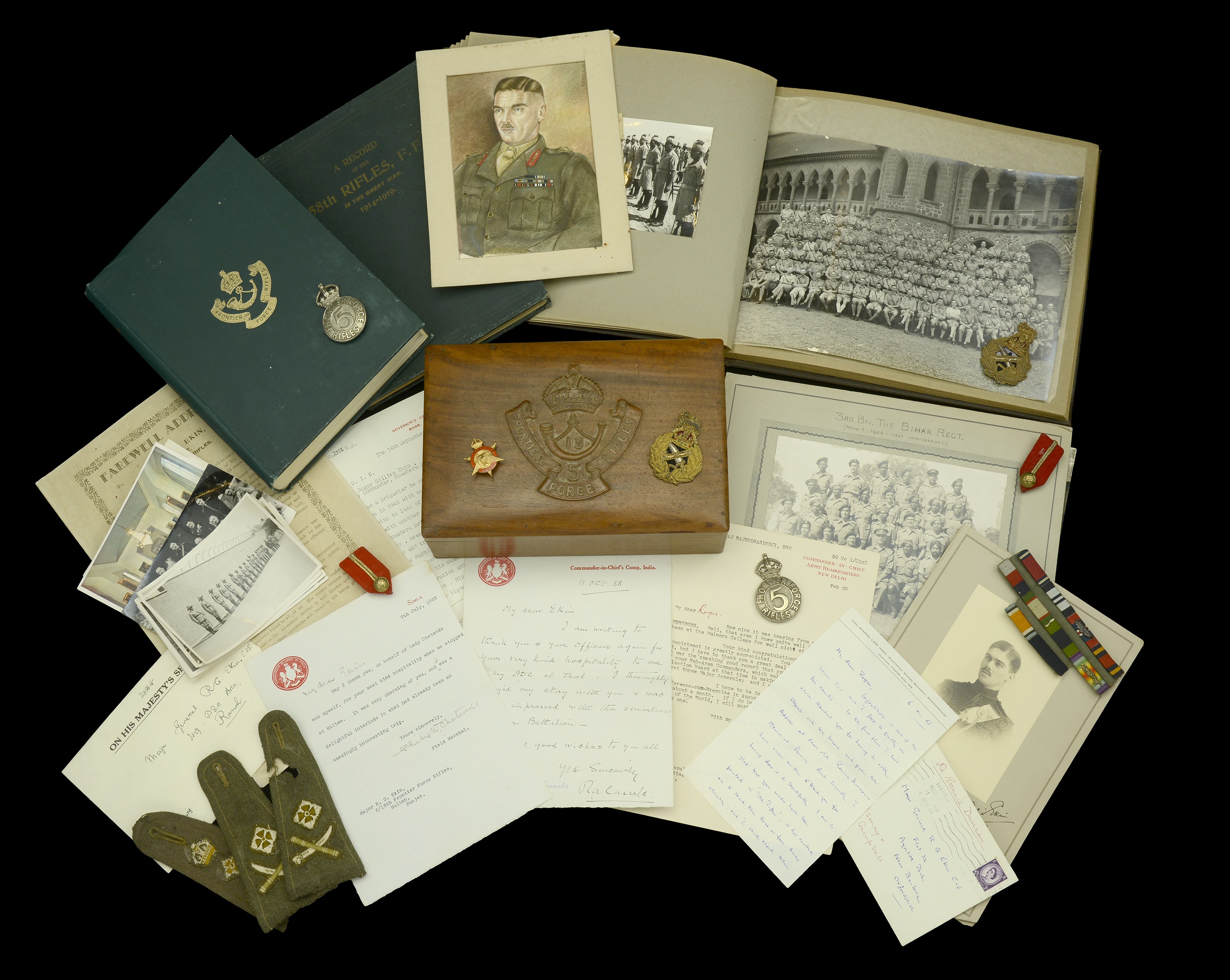A well-documented Second War C.I.E. group of ten awarded to Major-General R. G. Ekin, 58th Frontier Force Rifles, later 5th Battalion, 13th Frontier Force Rifles, Indian Army, who served in Egypt and Palestine during the Great War, where he distinguished himself in the capture of the Turkish stronghold of Tabsor, capturing with just 20 men a target that had been assigned to a Battalion. After seeing much action in Waziristan during the inter-War period, Ekin commanded the 46th Infantry Brigade in Burma during the Second World War, where he swam the 600 yards across the Sittang River to report to Divisional HQ after the bridge had been destroyed in the retreat from Burma. His services for the War effort being ‘of the highest order’, he subsequently served as General Officer Commanding, Bihar and Orissa, prior to Indian Independence, and during the course of his career was five times Mentioned in Despatches The Most Eminent Order of the Indian Empire, C.I.E., Companion’s 3rd type neck badge, gold and enamel, with short section of neck riband for display purposes; British War and Victory Medals, with M.I.D. oak leaves (Capt. R. G. Ekin.); India General Service 1908-35, 3 clasps, Afghanistan N.W.F. 1919, Waziristan 1921-24, North West Frontier 1930-31 (Capt. R. G. Ekin. 58 Rfls.); India General Service 1936-39, 1 clasp, North West Frontier 1937-39 (Lt-Col. R. G. Ekin, 5-13 F.F. Rif.); 1939-45 Star; Burma Star; War Medal 1939-45, with M.I.D. oak leaf; India Service Medal; Jubilee 1935, unnamed as issued, mounted as worn, good very fine and better (10) £2,400-£2,800 --- C.I.E. London Gazette 13 June 1946. The official citation states: ‘Major-General Roger Gillies Ekin, Indian Army Commander, Nowshera Brigade. Lately as a Brigadier he commanded a Brigade in Burma in 1942 with conspicuous success until owing to lack of numbers his Brigade was merged with another formation. He has since commanded Nowshera Brigade and by his outstanding ability, keenness and personality managed to build up and train raw units into a first class fighting machine in the shortest possible time. Apart from his essential military duties Brigadier Ekin by his example and devotion to duty created a co-operative and happy atmosphere throughout the station. His services to the War effort was of the highest order.’ M.I.D. London Gazettes 22 January 1919; 5 June 1919 (both Egypt); 12 June 1923 (Waziristan 1921); 20 June 1941 (Waziristan); and 28 October 1942 (Burma). Roger Gilles Ekin was born on 18 November 1895, the son of Colonel T. C. Ekin, and was educated at Westminster School and the Royal Military College, Sandhurst. He was commissioned Second Lieutenant on the Unattached List for the Indian Army on 1 October 1914, a significant achievement as in those days the Indian Army only accepted those who had passed out in the first 35 in the final Order of Merit; a certain Bernard Montgomery had passed out 36th and had been rejected. Posted to the 55th Rifles, Frontier Rifles, on 16 December 1914, he served during the Great War in Egypt from 1916, escorting a contingent of reinforcement for the Indian Corps on the Western Front, before transferring to the 58th Frontier Force Rifles, and was promoted Lieutenant on 1 October 1916. The following year, Ekin served during General Allenby’s campaign in Palestine, being present at the battles of Gaza, Megiddo, and Jerusalem. During the advance on Jerusalem in November 1917, the 58th Rifles were assigned to picquet the pass north-east of Latrun. The History of Palestine states that throughout history 26 attempts had been made to attack Jerusalem from the west, and all had failed; the 58th were therefore the first ever to penetrate and hold the pass, which allowed for General Allenby’s triumphal entry into Jerusalem. Subsequently receiving orders to join the 232nd Brigade at Jimsu, Ekin is mentioned in the History of the 5th Battalion, 13 Frontier Force Rifles for his services on 11 December 1917: ‘“A” Company, under Lieutenant R. G. Ekin, assisted the 2/3rd Gurkhas in the capture of Budras village, putting an enemy machine gun out of acting and making prisoners of a Turkish officer and ten men.’ Promoted Captain, Ekin’s final action of the Great War came at the capture of the strongly held village of Tabsor on 19 September 1918, a Turkish strong-point, heavily protected by barbed wire and cactus hedges: ‘The Regiment advanced in two waves at 150 yards interval, “A” Company (under Captain Ekin) on the left of the first wave. Covered by an intense bombardment from our guns the line advanced, and came three minutes later under the enemy counter-barrage. The Turkish front line of defence was taken, and at soon after Tabsor village was encircled, its defenders flying in a westerly direction.’ (ibid). A Record of the 58th Rifles, F.F., in the Great War 1914-19 adds the following detail: ‘During the advance on Tabsor, the Battalion was on a much broader front than was intended [Ekin himself says ‘The Battalion “side-stepped” several hundred yards to fill a gap vacated by a Battalion which had retired], and consequently Tabsor village itself, the assault on which the entire Battalion had been specially detailed, was actually encircled and taken by a mere handful of about twenty men under Captain Ekin and Jemadar Thakur Sing.’ For his services during the Great War in Egypt and Palestine, Ekin was twice Mentioned in Despatches, the latter Mention almost certainly for his gallantry at Tabsor, and was awarded the British War and Victory Medals. Appointed Adjutant of the 58th Frontier Force Rifles in February 1919, Ekin saw further service during the Waziristan campaigns on the North West Frontier of India, taking part in the operations against the Wana Wazirs in 1920 in the column under Sir Walter Leslie, and served at Wana, Rogha Kot, and Dargai Oba in 1921, the fighting described as ‘the most desperate and costly in the whole history of the Frontier.’ For his services Ekin was again Mentioned in Despatches and was awarded the India General Service Medal with two clasps. On 1 December 1922, the 58th Frontier Force Rifles was re-badged as the 5th Battalion, 13th Frontier Force Rifles. Appointed Deputy Assistant Adjutant-General in August 1924, in the inter-War years Ekin held various staff and regimental appointments, and saw further service during the campaign on the North West Frontier of 1930 when Peshawar was isolated, receiving a further clasp to his India General Service Medal. Advanced Brevet Lieutenant-Colonel in 1936, Ekin was appointed Commandant of the Battalion in May 1937, then stationed at Thal, on the North-West Frontier, and commanded the Kohat Brigade in operations against Mehr Dil during the unrest fermented by the Faqir of Ipi in Waziristan in 1938, and the subsequent uprising in the Bannu and Kohat districts, where the Battalion was tasked with protecting a 30-mile stretch between Banda Daud Shah and Bannu (Medal and clasp). Promoted Colonel in 1939, following the outbreak of the Second World War Ekin was appointed Commandant of the Tactical School, India, and then in 1941 was given command of the 46th Infantry Brigade, part of the 17th Indian Division; intended for service in Iraq, the division was instead sent to Burma at the end of 1941. In February 1942, having evacuated Moulmein in paddle steamers across the Salween estuary under Japanese shell-fire, and having fought a delaying action on the Bilin River, Major-General Smyth, V.C., the commander of the 17th Indian Division, decided to withdraw across the Sittang river, a more defensible obstacle. Ekin’s Times obituary takes up the story: ‘The ...















